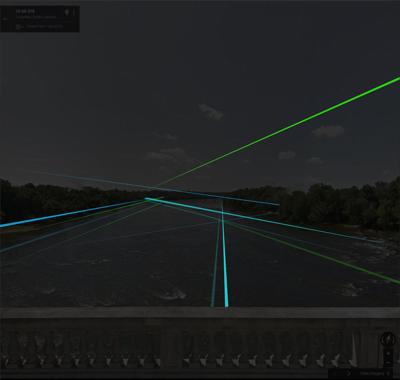
A 2017 rendering of Southern Lights.
In less than a month, officials will turn on a laser light art installation over the waters of the Congaree River.
Some residents aren’t exactly thrilled with the idea.
Southern Lights will formally begin Aug. 19 in association with Columbia’s Total Eclipse Weekend ahead of the Aug. 21 solar eclipse. The laser art installation is slated to be turned on for three hours every night for the next decade, or until the lasers no longer work. The times the lasers will beam over the Congaree each night will vary, depending on what time the sun sets.
The installation is being designed by Chris Robinson, a professor at the University of South Carolina’s School of Visual Art and Design. What’s Next Midlands, One Columbia for Arts and History, EngenuitySC, the Vista Guild, the State Museum, the City of Columbia and other entities collaborated in conjuring up the laser project.
Southern Lights will include the installation of two lasers near the Congaree River, one on top of the city’s pump station near Founders Park, and another at EdVenture. Several mirrors will be placed on the Gervais and Blossom bridges, as well as on other structures, like the Bridgepointe condos in West Columbia. The laser beams will be blue and green and will reflect off the mirrors in patterns that will be visible above the water.
On July 18, Congaree Riverkeeper Bill Stangler moderated a public discussion in the Canal Room at EdVenture in which project stakeholders — including What’s Next Midlands’ Laura Ros, One Columbia’s Lee Snelgrove and Robinson — heard concerns about the laser installation from the public. About 50 people attended the session, with many worrying about the frequency and longevity of the lasers and others fretting about how they might affect wildlife, particularly birds.
Local resident John Grego says he’s spent years as a bird watcher along the West Columbia and Cayce riverwalks and is worried about how the installation will impact birds including, among many other species, chimney swift, which he says he has seen “flocking by the dozens over the water in the evenings.”
“I do have some concerns that lasers will deter the wildlife activity that is so enjoyable to observe along the river at dusk,” Grego told the July 18 panel. “I definitely advocate a later start to the laser display that would not have an impact on the birds’ evening activities.”
Robinson says he’d be stunned if the lasers were harmful to birds.
“Birds and bats see it as a solid object,” Robinson says of the laser light. “So, they won’t approach it, they’ll fly around it. I’ve built a number of these things and we’ve never had any environmental problems. Never lost an animal or a bird. … One of the worst things and one of the best things about art and technology is you can turn it on and you can turn it off. If it causes a problem, we’ll turn it off and we’ll address the problem and fix it.”
Ros says she consulted with the Cornell Lab of Ornithology, which studies birds and other wildlife, about how birds may see the laser installation. She says the lab indicated that, as Robinson posits, birds would most likely see the beams as a solid and avoid them.
Robinson says he has been building laser installation displays for about 45 years, in various parts of the country, in urban and natural environments. He says he’s never had a complaint about a negative environmental impact of the lasers.
“I’m obliged by the Department of Agriculture to go through a process of approval,” Robinson says. “There’s very stringent guidelines on how [the lasers] can be done. Nobody would be hurt more than me if anything was wrong with one of these pieces or something did go wrong. I’ve bent over backwards to make them resilient and make them safe.”
Numerous speakers at the July 18 forum took issue with the idea that the lasers will be turned on each night, and for so many years. To some, it simply seems like overkill. Citizen Dave Schuetrum was among their number.
“I think it would be good to curtail the number of days,” Schuetrum said. “Having it all the time like that, I don’t agree with that.”
Grego, the aforementioned bird watcher, advocated “setting aside a couple days each week with no display, at all.”
Robinson says the lasers could be negatively affected if they start going days at a time without being activated.
“The interesting thing you may not be aware of technologically is that these are argon ion lasers,” Robinson says. “It sounds funny, but they like to be exercised. The more they run, the more successful they are. The way they go bad is when you don’t run them. So, we’d be very apprehensive about leaving them off for a period of time.”
That said, Snelgrove told Free Times that organizers will at least ponder the idea of reducing the number of nights per week the lasers are activated.
“Yeah, I think that will be considered,” Snelgrove says.
The City of Columbia, through One Columbia, will own and maintain the lasers.







